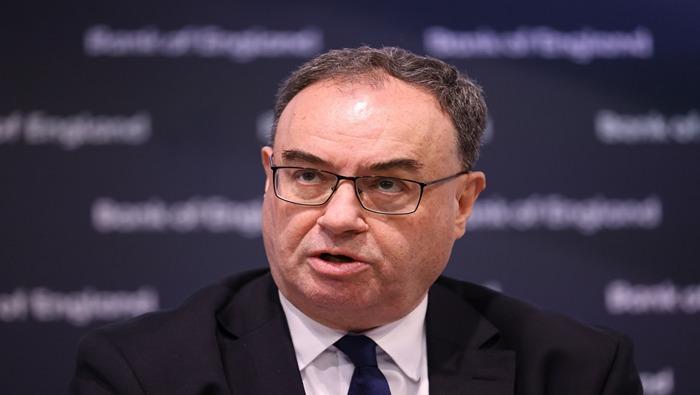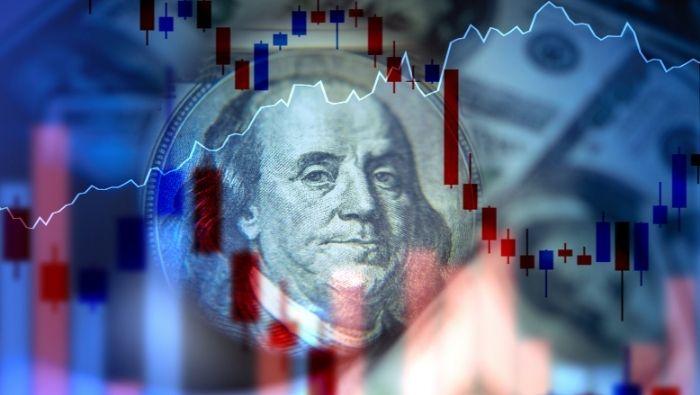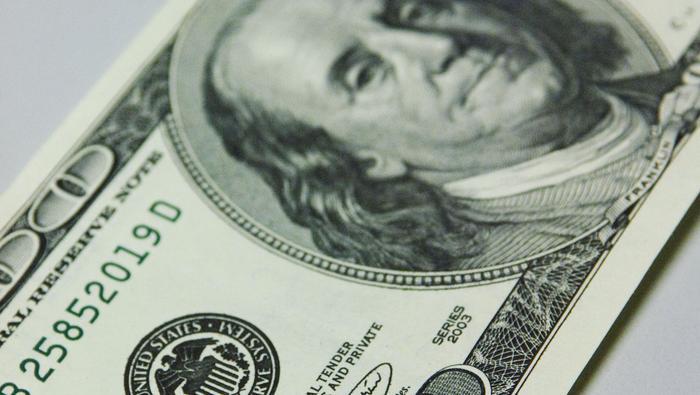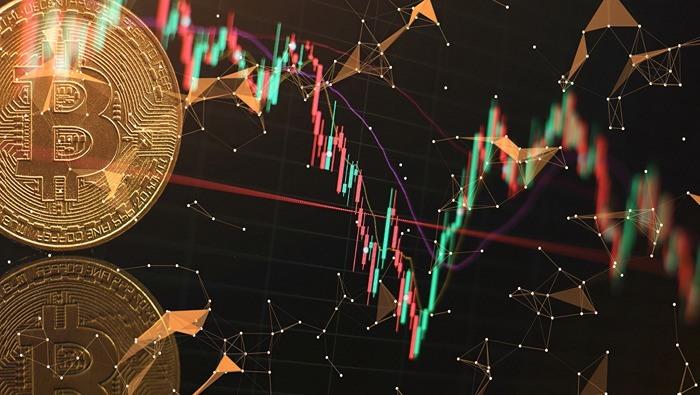2024-04-01 06:30
The Bank of England (BoE) turned dovish in the past few days and this means that a UK interest rate cutting cycle is on the way, and perhaps sooner than financial markets originally anticipated. BoE Governor Andrew Bailey recently communicated that UK interest rate cuts are on the way as inflation continues to fall towards the central bank’s target. Asked recently if current market rate cut expectations are realistic, Governor Bailey not only said that current rate expectation curve looks reasonable, but also added that ‘all our meetings are in play…we take a fresh decision every time.’ This last comment means that the May 9th meeting must now be treated as live, even though market pricing is showing the June 20th meeting as the most likely starting date for UK rate cuts. Financial markets are currently pricing-in just 6 basis points of cuts at the May meeting, although these implied rates can change quickly. Implied Rates & Basis points Source: Refinitiv From a technical angle, 10 year UK Gilt yields now look bearish after having fallen through the 20- and 50-day simple moving averages. A series of higher highs off the December low has been broken, while a trade below 3.89% will also negate the recent trend of higher lows. The next target is 3.73% followed by a longer-term target at 3.43%. Any move higher in yields will find stiff resistance between 4.13% and 4.20%, and unless there is a sudden change in UK macro policy, these levels will prove difficult to clear. The CCI indicator suggests that UK 10 year Gilt yields are oversold and so this reading needs to be negated in the near-term to allow yields to fall further over the coming weeks. Fine-tune your trading skills and stay proactive in your approach. Request the pound forecast for an in-depth analysis of the sterling’s fundamental and technical outlook. 10 Year UK Gilt Yield Daily Chart Source: TradingView, Prepared by Nick Cawley Q1 Trade Recap – Buy Coinbase (COIN) My Q1 trade was long Coinbase, and despite a small sell-off in January, this has performed strongly and is at, or very close, to our secondary target ($278). While this trade like it may have more to go, partial profit-taking or a moving stop loss should be considered to consolidate Q1 gains. Previous Quarter Coinbase Weekly Chart Source: TradingView, Prepared by Nick Cawley Current Coinbase Weekly Chart Source: TradingView, Prepared by Nicholas Cawley https://www.dailyfx.com/news/q2-top-trade-sell-10-year-uk-gilt-yields-20240401.html

2024-04-01 06:00
Top Trading Idea Q2 2024: Long USD/CHF Central banks have had their say for Q1 and there were arguably two surprises, both from central banks that have deployed negative interest rates in the recent past. The Bank of Japan decided to exit negative rates and the Swiss National Bank (SNB), in a surprise decision, voted to cut their benchmark interest rate – the first of the major central banks to do so. Lower inflation forecasts for Switzerland and meagre growth lay the foundation for further easing to come from the often-unpredictable SNB before Chairman Thomas Jordan steps down in September. In contrast, The Fed requires more confidence that recent hotter-than-expected inflation is headed towards the 2% target on a consistent basis while growth and the labour market remain resilient – supporting the dollar. Discover DailyFX's top 3 trades for the second quarter below: Contrasting Fundamentals Present an Opportunity for USD/CHF in Q2 Now that the SNB has pulled the trigger and cut rates, this allows other central banks to consider the doing the same. However, being the first mover, the Swiss Franc opened itself up to currency depreciation due to a worsening of interest rate differentials. For other nations still experiencing stubborn inflation, this would have been a concern but given the franc’s undesirable appreciation and Switzerland’s impressively low CPI (1.2% in February) – the decision to cut actually makes sense for the EU member state. Chart 1: Swiss GDP and Inflation Trend Lower Source: Refinitiv Datastream, Federal Reserve Bank A strong franc renders Swiss exports relatively less competitive compared with goods from countries with a weaker exchange rate. In addition, with inflation so low, Switzerland is able to absorb any imported inflation that may accrue as a result of the rate cut – but this is unlikely to be significant given its just a single 25 basis point cut for now. Central Bank Policy Could Extend Bullish USD/CHF Setups in Q2 Market expectations foresee a strong chance (78%) of another 25-bps rate cut from the SNB in June and if the likelihood of that second cut gains momentum, perhaps on softer inflation or weaker GDP, the franc may depreciate further as markets price in such an outcome. Implied Rate Cuts and Probabilities Source: Refinitiv In addition, the Fed only just maintained their projection of three rate cuts to come in 2024. The Fed’s dot plot takes into account the median value of the 19 estimates, meaning that the 10th dot represents the median. The chart below shows that had one more dot been placed between 4.75% and 5%, the result would have confirmed the likelihood of the Fed removing a cut this year – which would likely have seen the dollar rise in the moments after the meeting. The near miss suggests that members at the Fed have lingering reservations about easing financial conditions given robust US data. If the strong data persist, markets may continue to support the dollar in Q2. Chart 2: Fed Dot Plot March 2024 Source: Refinitiv Datastream, Federal Reserve Bank The Trade: Long USD/CHF Upon Improved Entry Point USD/CHF spent most of 2023 trending lower in a rather choppy fashion, but at the turn of the new year fortunes reversed. The pair traded higher and eventually broke above trendline resistance on the back of the surprise cut by the SNB. The guidance to this trade suggests looking to enter the developing uptrend at a better level due to the sharp ascent at the end of Q1. Another sign to wait for a better entry level appears via the rejection of higher prices at the 38.2% Fibonacci retracement of the 2023 decline. A move back down to 0.8829 would reveal a retest of trendline support (prior resistance), whereafter, a bullish continuation may provide a higher probability trade. A level to consider includes 0.9085 which serves as a tripwire for continued bullish price action. Thereafter, upside targets comprise of 0.9245 and 0.9473. A retest of the late 2023 low would invalidate the bullish setup. Weekly USD/CHF Chart Source: Tradingview, Prepared by Richard Snow https://www.dailyfx.com/news/top-trading-idea-q2-2024-long-usd-chf-20240401.html

2024-03-31 15:00
Most Read: Euro Outlook - Market Sentiment Signals for EUR/USD, EUR/GBP, EUR/JPY The first quarter of 2024 wrote a chapter in market history. Relentless AI hype propelled tech-heavy indices to dizzying new heights, with giants like Nvidia, Alphabet, and Microsoft riding the wave of investor euphoria. Additionally, expectations regarding Federal Reserve’s monetary policy outlook buoyed risk assets. Although the Fed maintained its stance throughout the first quarter, policymakers indicated that they were “not far” from gaining greater confidence on the inflation outlook to start reducing borrowing costs, following one of the most aggressive tightening cycles in decades between 2022 and 2023. Against this backdrop, the S&P 500 surged by 10.15%, closing at an all-time high of 5,254. Similarly, the Nasdaq 100 registered significant gains, albeit at a slightly slower pace, climbing by 8.5%, building upon the 14% increase witnessed in the October-December period of 2023. Elsewhere, gold, which encountered challenges early in the year, embarked on a strong bullish reversal beginning in mid-February. This surge, partly driven by speculations that the FOMC would prioritize economic growth over inflation concerns and start easing its stance as soon as June, drove the precious metal to a historic peak exceeding $2,200 by late March. US Equity Indices and Gold Q1 Performance Source: TradingView In the FX space, the U.S. dollar exhibited notable strength across its top peers, particularly against the Japanese yen. USD/JPY, for instance, soared more than 7% throughout the first quarter, edging tantalizingly close to reclaiming the psychological 152.00 level, the line in the sand for the Japanese government. The yen couldn’t draw support from Bank of Japan’s move to abandon negative rates as the institution said that financial conditions would remain accommodative for the foreseeable future. Traders interpreted this dovish signal as indicative of a slow normalization cycle for the country, which would sustain its yield disadvantage relative to other economies. For a complete overview of the U.S. dollar’s technical and fundamental outlook, request your complimentary Q2 trading forecast now! Looking ahead, we anticipate shifts in market dynamics driven by a global trend towards looser monetary policy, assuming no significant upside inflation surprises. This may provide support for risk assets, especially in the context of improving and stabilizing economic growth. Meanwhile, the U.S. dollar could head lower, but its downside would be limited if other central banks end up adopting a more dovish outlook than the Fed. The second quarter promises a whirlwind of market forces, setting the stage for exciting trading opportunities across currencies, commodities, and cryptos. Will the recent trends persist, or will new players emerge? For expert insights into the catalysts shaping Q2, dive into DailyFX's comprehensive technical and fundamental forecasts. Your next winning trade awaits – unlock the potential! TECHNICAL AND FUNDAMENTAL FORECASTS FOR Q2 Australian Dollar Q2 Fundamental Forecast: Long AUD/USD Downtrend May Be Fading at Last This article concentrates on the fundamental outlook for the Australian dollar, analyzing market catalysts and key drivers that are expected to exert significant influence on the currency's dynamics in the second quarter. Japanese Yen Q2 Technical Forecast: USD/JPY, EUR/JPY, GBP/JPY at Critical Juncture This article explores the technical prospects of the Japanese yen for the second quarter across three key pairs: USD/JPY, EUR/JPY, and GBP/JPY. The piece considers both price action dynamics and market sentiment for a comprehensive and holistic outlook. British Pound Q2 Fundamental Outlook- Will the Bank of England Join the Q2 Rate Cutting Club? The Bank of England's Monetary Policy Committee adopted a dovish stance at its last meeting, sparking debate about the possibility of policymakers bringing forward their first interest rate cut. Interest rate expectations could have a strong impact on the pound in Q2. Equities Q2 Technical Outlook: Record Breaking Stocks Show no Signs of Slowing Down After printing multiple all-time highs, US indices now trade at or around new highs with little sign of fatigue. Fibonacci projections provide an indication of where prices may be headed. Crude Oil Q2 Fundamental Forecast – OPEC’s Cuts Will Keep Prices Underpinned Crude oil prices may continue to rise in the second quarter of 2024, but they remain subject to the considerable short-term uncertainty that dogged them at the start of the year. Cryptocurrencies Q2 Technical Forecast: Bitcoin, Ethereum, Solana. What’s Ahead? In this article, we explore the Q2 technical outlook for Bitcoin, Ethereum and Solana, analyzing sentiment and major price thresholds worth watching in the near term. Gold Q2 Fundamental Forecast: In Neutral Waters - Neither Bullish nor Bearish This article provides an in-depth analysis of the fundamental outlook for gold prices in the second quarter, examining critical market themes and key drivers that could play a pivotal role in shaping the precious metal's trajectory. Euro Q2 Technical Forecast: EUR/USD, EUR/GBP, and EUR/JPY EUR/USD has had a bumpy ride so far this year with the most actively traded FX pair starting the year just off a six-month high before sliding to a multi-week low in mid-February. See what Q2 has in store. US Dollar Q2 Forecast: Dollar to Push Forward as Major Central Banks Eye Rate Cuts The US dollar performed phenomenally in Q1 - something that is likely to continue but perhaps to a lesser degree now that growth is moderating, and rate cuts come into focus. Fine-tune your trading skills and stay proactive in your approach. Request the EUR/USD forecast for an in-depth analysis of the euro’s fundamental and technical outlook! https://www.dailyfx.com/news/markets-q2-outlook-gold-stocks-bitcoin-us-dollar-euro-pound-yen-whats-ahead-20240331.html

2024-03-31 10:30
US Economy Moderates but Remains a Standout Amongst its Peers The US economy, according to the latest data from the Atlanta Fed’s GDP Now forecast, is projected to grow by 2.1% in Q1, after growing 3.2% in Q4 of 2023 and a massive 4.9% the quarter before that. While growth is clearly moderating, it remains stronger than other developed nations such as Europe, with is stagnant growth; and the UK which entered a technical recession in Q4. As such, the dollar is likely to remain supported into Q2 due to the potential for hotter activity and a robust labour market to add to existing inflationary pressures - which ultimately justify interest rates remaining ‘higher for longer’. Graph 1: Atlanta Fed’s GDP Now Projection for Q1 Using Currently Available Data Source: Federal Reserve Bank of Atlanta Even Federal Reserve Bank officials were forced to confront the impressive level of growth as the March summary of economic projections included an upward revision for full year growth to reach 2.1%, up from 1.4% forecasted in December. Robust Labour Market Necessitates Caution from the Fed In the March Fed statement, officials agreed that risks to employment and inflation goals are moving into better balance, which can be viewed as optimism for a ‘soft landing’ – a situation where the Fed brings inflation down without sparking mass unemployment or a deep, long-lasting recession. The Fed alluded to the overall resilience of the labour market by stating that job gains remain ‘strong’. January saw 229k jobs added while February contributed another 275k. However, signs of easing have appeared in the data that typically precedes larger declines in non-farm payroll data, and this is via the job opening and labour turnover (JOLTs) survey. There is a growing trend developing that sees fewer people quitting, fewer employers hiring and fewer available jobs, but the trend is in its infancy and hasn’t spilled over into actual jobs data. The longer this remains the case, the longer the Fed may have to hold out on rate cuts. Graph 2: JOLTs Data Showing Job Openings, Quitting and Hiring Source: Refinitiv DataStream, US Bureau of Labour Statistics (BLS) The Fed Acknowledges Inevitable Rate Cuts but Timing Remains Uncertain The upward revisions to both growth and inflation for 2024 sends a signal to the market that fundamentals remain strong and interest rate cuts will need to remain on the backburner until June or even July – according to current market implied expectations. Other central banks, however, are not so fortunate. Several European Central Bank (ECB) officials, for example, have explicitly come out and identified June as a potential start date for rate cuts and will be hoping that the stagnant economy can hold on until then. Should incoming data sour even further, markets may start to price in an earlier hike or anticipate more than three cuts this year for the EU – which could weigh on EUR/USD. Since EUR/USD contributes more than 57% towards the US dollar basket (DXY), this is expected to support the benchmark of USD performance in Q2. The dollar has strengthened against most currencies this year (so far) and is likely to continue to benefit from a superior interest rate differential. Global foreign exchange rates Source: Thompson Reuters Risks to the Bullish Outlook: Economy, Unemployment, and Inflation Inflation has produced several hotter-than-expected prints in 2024 in some way or another which has led the Fed to dismiss any notion of imminent rate cuts. The risk in Q2 is that the hotter, seasonal factors buoying inflation, reverse. Rapidly declining inflation alongside robust jobs market significantly weakens the argument for maintaining rates at elevated levels. In addition, the US economy is moderating – declining from annualised growth of 4.9% in Q3 to 3.2% in Q4 and on track for 2.1% in Q1 this year. Should signs of weakness appear, the Fed will be motivated to cut rates to avoid a recession. Employment is another factor that is keeping the economic machine humming. Job security and an abundance of available jobs has supported consumption and consumer spending to a large degree. A sharp decline in employment and news of increased layoffs pose a potential threat to the dollar in Q2, but current data remains strong. https://www.dailyfx.com/news/us-dollar-q2-forecast-dollar-to-push-forward-as-major-central-banks-eye-rate-cuts-20240331.html

2024-03-30 21:30
Market Recap: New Record in the Books Gold achieved an extraordinary feat in the first quarter, surpassing its previous record and shattering the $2,200 per ounce barrier. This rally was fueled primarily by investor anticipation of a dovish shift in the outlook for monetary policy. After a series of aggressive rate hikes in 2022 and 2023 across much of the developed world, investors expect the Fed and other key central banks to begin removing restriction in the upcoming months as economic growth and inflation moderate. With much of the projected transition to a looser stance already priced in into bullion’s valuation, the scope for upward movement may be constrained in the future, particularly considering the 17% increase already observed in the past six months. For substantial material gains, the Federal Reserve would need to adopt a more dovish posture- something that seems improbable given recent guidance and growing inflation risks. Presently, investors anticipate about 75 basis points of easing from the FOMC in 2024. If the FOMC were to delay action due to stubborn prices pressures and if expectations regarding its policy roadmap were to shift towards a more hawkish direction, gold could be in for a turbulent ride. Generally speaking, gold tends to benefit from lower Treasury yields and a weaker U.S. dollar, conditions often associated with the Fed reducing borrowing costs. The following below shows current FOMC meeting probabilities for the next nine meetings. FOMC meeting probabilities Source: CME Group, Prepared by Diego Colman Beyond the Fed: Geopolitics, Central Bank Demand Global interest rates will not be the only factor influencing gold’s trend. Lingering conflicts, notably those related to the Russia-Ukraine war, which have already built up a geopolitical premium in the precious metal, could emerge once again as a more significant pillar of support if tensions escalate in the upcoming quarter. Additionally, strong physical gold purchases by central banks are likely to be another source of market strength. By way of context, in 2022 and 2023, central banks collectively acquired over 1,000 tonnes of gold each year, setting a historic pace, with the Central Bank of Turkey and the People's Bank of China being two active buyers. Central banks have been buying gold at a record pace because of its safe-haven qualities in times of turmoil, its reputation as a stable store of value, and its usefulness for diversification. As global power dynamics shift and U.S. dominance becomes less certain, central banks have been strategically reallocating their reserves, moving away from heavy reliance on the U.S. dollar, which has traditionally formed the bulk of their holdings. Although comprehensive data for 2024 remains somewhat limited, January's central bank acquisitions of 39 tonnes and projections from the World Gold Council indicate that demand could continue to be robust throughout the year. This could act as a buffer in the event of a bearish reversal in prices, thus limiting potential losses in a downward correction. Central Banks gold buying Source: Metals Focus, Refinitiv GFMS, ICE Benchmark Administration, World Gold Council The Outlook: Neutral with a Watchful Eye The second quarter may see a period of consolidation for gold, following its impressive gains in the year's first months. With that in mind, a dramatic price surge in either direction is unlikely barring an unexpected shift in global inflation dynamics and the monetary policy outlook. Investors should closely monitor economic data, central bank communication, and global geopolitical developments. These factors will provide important clues about the precious metal’s trajectory in the coming months. Later in the year, as the November U.S. presidential election draws near, heightened volatility, customary during such periods, may potentially be a tailwind for gold prices, traditionally considered a defensive investment in times of uncertainty. However, this theme is not expected to dominate the market in the second quarter just yet. https://www.dailyfx.com/news/xau-usd-gold-q2-fundamental-forecast-in-neutral-waters-neither-bullish-nor-bearish-20240330.html

2024-03-30 18:00
Bitcoin, Ethereum, and Solana Technical Analysis The technical outlook for Bitcoin, and Ethereum, looks positive but with bouts of volatility expected in the coming months. The positive drivers – described in the Fundamental Outlook – drove BTC/USD to a fresh high in mid-March before a small retracement drove Bitcoin back to its previous ATH. Looking at the daily chart, Bitcoin looks set to press higher over the coming weeks with the current spot price above all three simple moving averages – just in the case of the 20-day sma – while the CCI indicator shows BTC/USD as oversold. The Average True Range (ATR) indicator is at levels last seen in mid-2021 and highlights the current level of volatility in the space. Bitcoin is set to move higher but sharp downturns along the way are to be expected. Bitcoin Daily Price Chart Source: TradingView, Prepared by Nick Cawley The Q2 outlook for Ethereum also looks positive, with a very similar daily chart to Bitcoin. While Bitcoin has made a fresh all-time high this year, Ethereum is still a way below the November 2021 ATH at $4,860. The recent triple-top at just under $4,100 is the next upside target and if this is broken then $4,400 and the November 2021 ATH will come into play. Ethereum is currently oversold, using the CCI indicator, and volatility is at multi-month high levels. A fresh all-time high may prove difficult in the second quarter but a pushback above $4k looks likely for Ethereum. Ethereum Daily Price Chart Source: TradingView, Prepared by Nick Cawley Solana traders have had a wild ride of late with the L1 coin rallying from the mid-teens in September 2023 to a recent $210 high. Increased Solana network activity due to renewed market enthusiasm for a range of meme coins has boosted the Solana share price by nearly 10x in six months. Interest for Solana remains high in the current market, and this should see the recent $210 high re-taken in the coming weeks. The all-time high around $260 may prove trickier in the coming quarter, although bullish traders will point to Solana being above all three simple moving averages. Solana Daily Price Chart Source: TradingView, Prepared by Nick Cawley https://www.dailyfx.com/news/cryptocurrencies-q2-technical-forecast-bitcoin-ethereum-solana-what-s-ahead-20240330.html
